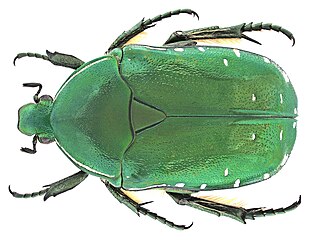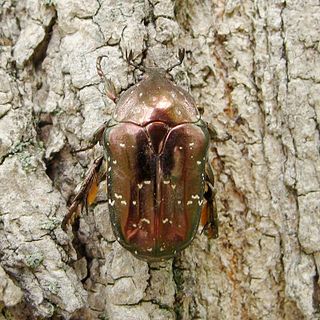
Cetonia aurata, called the rose chafer or the green rose chafer, is a beetle, 20 millimetres long, that has a metallic structurally coloured green and a distinct V-shaped scutellum. The scutellum is the small V-shaped area between the wing cases; it may show several small, irregular, white lines and marks. The underside of the beetle has a coppery colour, and its upper side is sometimes bronze, copper, violet, blue/black, or grey.

The family Scarabaeidae, as currently defined, consists of over 35,000 species of beetles worldwide; they are often called scarabs or scarab beetles. The classification of this family has undergone significant change in recent years. Several subfamilies have been elevated to family rank, and some reduced to lower ranks. The subfamilies listed in this article are in accordance with those in Catalog of Life (2023).

Palmoplantar keratodermas are a heterogeneous group of disorders characterized by abnormal thickening of the stratum corneum of the palms and soles.

The Guldbagge Awards is an official and annual Swedish film awards ceremony honoring achievements in the Swedish film industry. Winners are awarded a statuette depicting a rose chafer, better known by the name Guldbaggen. The awards, first presented in 1964 at the Grand Hôtel in Stockholm, are overseen by the Swedish Film Institute. It is described as the Swedish equivalent of the Academy Awards.

The noble chafer is a species of beetles belonging to the family Scarabaeidae, subfamily Cetoniinae.

Flower chafers are a group of scarab beetles comprising the subfamily Cetoniinae. Many species are diurnal and visit flowers for pollen and nectar, or to browse on the petals. Some species also feed on fruit. The group is also called fruit and flower chafers, flower beetles and flower scarabs. There are around 4,000 species, many of them still undescribed.

Macrodactylus subspinosus is a North American beetle of the family Scarabaeidae. The members of its genus are known as "rose chafers", not to be confused with the European rose chafer, Cetonia aurata. M. subspinosus occurs from Eastern Canada to Colorado and is considered a pest of many crops and flowers. It is given its common name of rose chafer because it eats the leaves of roses, although it also feeds on many other plants.

Angophora hispida grows as a mallee, or as a tree to about 7 m (25 ft) in height. A. hispida's small size, especially when compared to its Angophora and Eucalyptus relatives, leads to it being known by the common name dwarf apple. It is native to a relatively small patch of central New South Wales – from just south of Sydney up to the Gosford area. The plant's leaves are sessile (stalk-less) and hug the stem with heart-shaped bases. Its previous name – A. cordifolia – referred to these cordate leaves. Another distinctive feature are the red bristly hairs that cover the branchlets, flower bases and new growth. This leads to the specific epithet hispida.

Eupoecila australasiae, commonly known as the fiddler beetle or rose chafer, is a colourful green- or yellow-and-black member of the scarab beetle family from eastern Australia.

The Noronha skink is a species of skink from the island of Fernando de Noronha off northeastern Brazil. It is covered with dark and light spots on the upperparts and is usually about 7 to 10 cm in length. The tail is long and muscular, but breaks off easily. Very common throughout Fernando de Noronha, it is an opportunistic feeder, eating both insects and plant material, including nectar from the Erythrina velutina tree, as well as other material ranging from cookie crumbs to eggs of its own species. Introduced predators such as feral cats prey on it and several parasitic worms infect it.

Persicaria punctata is a species of flowering plant in the knotweed family known by the common names dotted smartweed and dotted knotweed.

Rhabdotis is a genus of the family Scarabaeidae.

Protaetia is a genus of beetles of the family Scarabaeidae, occurring primarily in Asia, and containing over 300 species.

Anoplognathus viridiaeneus, commonly known as the king Christmas beetle, is a beetle of the family Scarabaeidae native to eastern Australia. The largest Christmas beetle, it can be over 3 centimetres (1.2 in) long.

Phoracantha is a genus of eucalyptus borers in the family Cerambycidae. There are at least two described species in Phoracantha.
Cetonia elegans may refer to:

Cetoniini is a tribe of fruit and flower chafers in the family of beetles known as Scarabaeidae. There are over 80 genera in Cetoniini, found worldwide.

Euphoria inda, the bumble flower beetle, brown fruit chafer or Indian cetonia is a species of beetle in the family Scarabaeidae. It is found in North America. While in flight, adults of this species do not lift their elytra, creating a buzzing sound as the hindwings vibrate inside. The adult beetle is a pollinator and feeds on pollen, nectar, sap and damaged fruits.

Hypericum punctatum, the spotted St. John's wort, is a perennial herb native to North America. The yellow-flowered herb occurs throughout eastern North America into southern Canada. The process of microsporogenesis carried out by this plant is prone to errors in chromosomal segregation. It has a diploid number of 14 or 16. Insects are attracted to the plant's pollen and the hypericin in the plant's leaves is toxic to mammals.


















